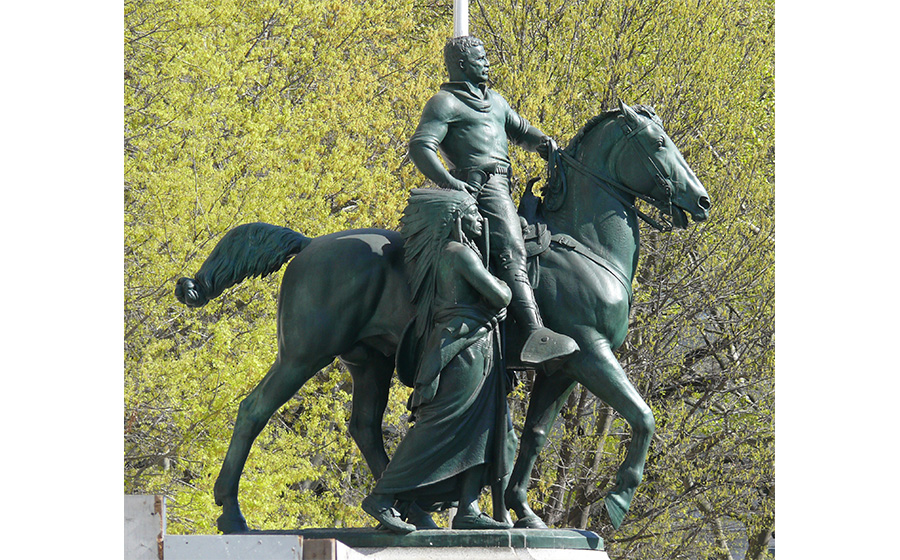
A New York City committee finds solutions amidst controversies
How do we reconcile our present values with outmoded historical beliefs and moralities that no longer hold truth for us today? This question lay at the core of New York City’s advisory board tasked with reviewing all symbols of hate on city property. Mayor Bill de Blasio convened the Mayoral Advisory Commission on City Art, Monuments, and Markers in 2017, and Darren Walker, President of the Ford Foundation, and Tom Finkerpearl, the Commissioner of the NYC Department of Cultural Affairs, chaired the committee, which included scholars of public history and art, artists, environmentalists, and community leaders.
According to its final report, one of the advisory board’s principle goals was “reckoning with power to represent history in public.” This problem poses an even greater challenge when art is involved, perhaps because monuments and statues play such a significant role in creating national identity and constructing history. Monuments often represent more than the person or event they commemorate, potentially symbolizing deeply engrained power structures and ideologies. It’s the reason why iconoclastic sentiments arise when discussing such contested sites.
The committee conducted historical research, public surveys, and hearings in every borough, then began a dialogue about possible resolutions. After considering recommendations from local communities and glaring historical oversights, they selected four monuments that had “sustained adverse public reaction” over the course of two or more years to undergo a laborious review: the Dr. J. Marion Sims Monument, located in Central Park at Fifth Avenue and 103rd Street; the Marker for Marshal Philippe Petain on Lower Broadway; the Equestrian Statue of Theodore Roosevelt in Roosevelt Park at the American Museum of Natural History; and the Christopher Columbus Monument in Columbus Circle.
The committee also developed four resolution options: removal; relocation; adding supplementary materials such as texts, programs, performances, and counter-monuments; and recontextualization. The only option not up for discussion was the complete destruction of a monument.

In an interview, committee member and art historian Harriet F. Senie said, “Tearing down a statue is a symbolic action—it doesn’t address the actual problem.” She explained that removing a monument can be perceived as a political act, one that erases history instead of confronting racist behaviors and beliefs. Senie acknowledged that although each case is different, an additive and educational approach is often best practice. Supplementary performances, texts, and public programs can be offered, both onsite and around the city, to discuss complicated issues more directly.
The removal of Dr. J. Marion Sims Monument in 2018 offers one example. The monument memorialized him as the “father of modern gynecology” without mentioning his inhumane experiments on enslaved black women. Senie suggested holding a series of programs on women’s health hosted by the New York Academy of Medicine. Public programs and performance art have the power to disrupt systemic attitudes and ways of thinking. These ephemeral solutions bring relevance to contemporary viewers, but they are not permanent.
The advisory board also discussed the possibility of commissioning counter-monuments by contemporary artists. Counter-monuments are contemporary structures placed on or near historical sites in order to stir critical conversation around the monument’s meaning. They help us reexamine how and who we memorialize through a contemporary lens. Artist-created counter-monuments can be powerful, because they allow the preservation of the original monument while recontextualizing and educating the public about underrepresented histories. But Senie also questioned the act of potentially altering historic art. She asked, “At what point are we somehow infringing on a certain kind of artistic integrity?”
Senie mentioned the Equestrian Statue of Theodore Roosevelt as an example. In the 1930s, James Earle Fraser, an important artist at the time, was commissioned to sculpt the monument. Today many believe the hierarchal structure of the statue embodies the white supremacist, imperialist beliefs of the era. Roosevelt sits on top of a horse, towering over the African and Native American figures below him. How would a contemporary artwork on this site affect the artist’s original intent? Historical artifacts and original works of art are essential to the work of art history, yet historical objects gain power because of the belief that originals hold inherent truths. The dilemma is whether we can achieve a truthful history without preserving symbols of hate and oppression.
In its concluding report, the committee wrote, “It is understood that collective reconciliation can only be achieved with collective truth, based on a shared understanding of historical facts.” Achieving this goal requires engaging multiple perspectives to create a more inclusive understanding of history. The work of the commission marks one important step in reaching a more just, equitable representation of public art and history. The city is also planning to erect more monuments of overlooked historical figures, including women and people of color. New York City must persist in searching for new ways to reckon with power in public spaces, particularly as the pedestals of controversial figures still left standing continue to cast a shadow upon the new narratives struggling to emerge.
About the Contributor
Anna Cahn is a curatorial assistant at the Rubin Museum of Art. She received her BA from Clark University and an MA in art history with a concentration in museum studies from the City College of New York. She was awarded a summer residency as a research fellow at Stanford University in 2014.




__small.jpg)